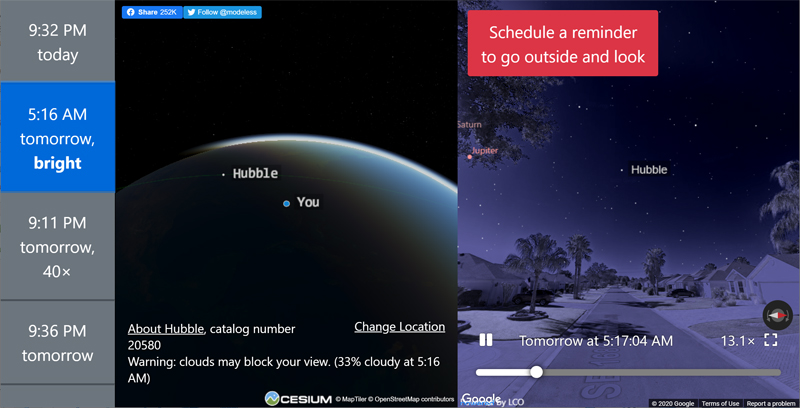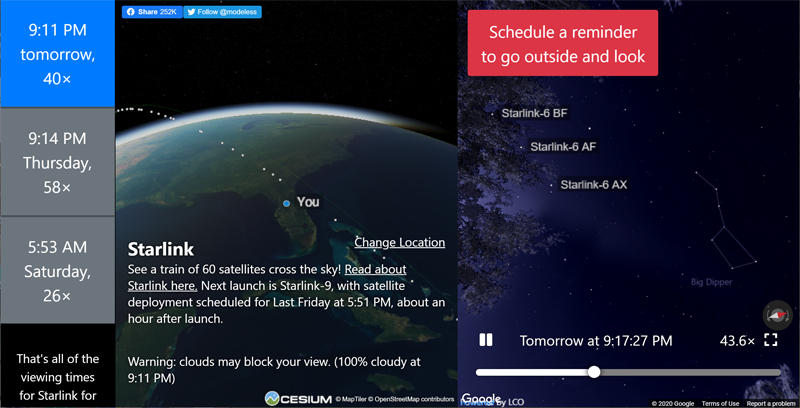
NEWS – There are a lot of satellites circling this blue marble we call home. YOu may not realize that many of these tin cans floating over our heads are actually visible to the naked eye if you know where to look.
If you want to see one of these satellites with your own set of peepers, Google engineer James Darpinian put up a website that tracks satellites and their location. It then ties that together with your location and tells you when satellites will be visible where you are. It provides clickable tiles along the left side of the page with the time the satellite will be visible. Clicking on it gives you a relative view on the right, approximating what you will see so you know where to look. You can also click the red box to add an event to your calendar. It supports browser notifications, Google Calendar, and iCal notifications. The left side shows a bird’s-eye view above the Earth, showing the flight path of the satellite. There are also links to more information about the specific satellites so you can learn more about what you’re looking at.
You can visit the site at james.darpinian.com/satellites/.
James added a sub-page dedicated to SpaceX’s Starlink constellation. The main page shows the Starlink satellites as well, but if Starlink is your main interest, this page shows only Starlink sightings and the number of satellites you can see along with the same trajectory and view information as the main page.

Starlink spotting is fun because you can see multiple satellites all moving in a line across the night sky. You can go directly to the Starlink page at james.darpinian.com/satellites/?special=starlink.
Both pages also let you change locations in case you want to know what’s visible somewhere else on the Earth. The page is seriously cool and worth a visit. Take a look and go spot a satellite tonight!



Gadgeteer Comment Policy - Please read before commenting
The links to the ISS and Starlink sats work, but is there a way to input an arbitrary catalog number. For example, the image in your post shows the Hubble telescope — how did you do that?
Larry:
This isn’t my website – I just reported on it. The features are what they are, and it doesn’t look like you get to choose satellites – just location – and it will show you what’s visible over the next five days.
The time seems to be off. I went out early and saw the satellite, but if I go out at the time specified it has already gone over.
Hello James.
Can you suggest reasons (apart from the obvious, clouds, light pollution, etc) why I’m not seeing Starlink satellites? I use your program extensively and I have seen a few starlinks but not many at all. Last August, though, I did get a great shot of a bunched up train shortly after deployment. The photography was naff but it served it’s purpose.
I live under some of the orbits, in South Wales, UK, and have a clear view (although badly polluted) of the tracks shown on your program. Also, on many night I have a clear view of The Plough and Arcturus and can see clearly Megrez, the dimmest star the plough, at, I believe, a VM of 3.6, so I should be able to see Starlinks. I usually wait for around 10 mins either side of the projected time, but alas, apart from 2 satellites (quite bright) a few night ago I see nothing.
I should also add that I occasionally see other satellites and the ISS is no problem.
Any tips?
Best regards.
Allan
Allan:
I just reported on the website. I did not develop it. You should probably direct your questions to the website developer.